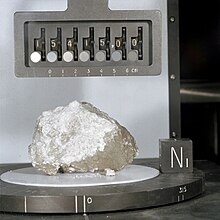On the basis of lunar rocks brought back by the astronauts, explain why the maria are dark-colored, but the lunar highlands are light-colored?
Regions of both the near side and far side of the Moon not covered by mare basalt are called highlands. The highlands consist of the ancient lunar surface rock, anorthosite, and materials thrown out during the creation of the impact basins. (“Lunar Rocks | National Air and Space Museum,” n.d.)
 The anorthosite rock highlands are brighter than the maria basalts. Pulverized by meteoric action, both the basalts of the maria and the anorthosite of the highlands are covered by a blanket of powdered rock, also known as regolith. The term regolith refers to any layer of material covering solid rock, which can come in the form of dust, soil or broken rock. The word is derived from the combination of two Greek words – rhegos (which means “blanket”) and lithos (which means “rock). (Williams, 2016)
The anorthosite rock highlands are brighter than the maria basalts. Pulverized by meteoric action, both the basalts of the maria and the anorthosite of the highlands are covered by a blanket of powdered rock, also known as regolith. The term regolith refers to any layer of material covering solid rock, which can come in the form of dust, soil or broken rock. The word is derived from the combination of two Greek words – rhegos (which means “blanket”) and lithos (which means “rock). (Williams, 2016)
 In addition to being brighter, the highland anorthosite is also older than the the maria basalts, by nearly a billion years. Geologically speaking, the Moon has remained quiescent and mostly unchanged for the last three billion years.
In addition to being brighter, the highland anorthosite is also older than the the maria basalts, by nearly a billion years. Geologically speaking, the Moon has remained quiescent and mostly unchanged for the last three billion years.
- Pristine Highland Rocks –

Anorthosite ‘Genesis Rock’ Apollo 15 NASA As their name implies, pristine highland rocks are rocks collected mainly in the lunar highlands that have not been substantially altered by reheating since they were first formed. These rocks may represent material from the original lunar crust that formed between 4.6 and 4.3 billion years ago. The chemical composition of these rocks implies the outer layers of the Moon experienced extensive melting in its early history. These types of rocks are very rare in the Apollo collection. The most famous of these rocks is the “Genesis Rock” collected by Apollo 15. (Smith, n.d.)
- Mare Basalts –

Basalt Apollo 15 NASA The first lunar samples brought back by Apollo 11 from Mare Tranquillitatis were black volcanic basalts. The basalts came from different depths, from the surface down to 100’s of meters deep, spilling out onto the mare surface as very fluid lava, filling up the large impact basins of the Moon. They have ages ranging from 3.2 to 3.9 billion years. They are very similar to terrestrial basalts except for some minor chemical differences. Lunar basalts have fewer iron-like elements and fewer elements with low melting temperatures (volatiles). (Smith, n.d.)
The dark mare basins were created after the anorthosite crust solidified from low-density magma that rose to the lunar surface by planetesimal impacts which filled with lava from the lunar interior. Despite a low lunar albedo (fractional reflectivity) of only about 0.12 (reflecting a mere 12% of the light hitting it and absorbing the rest), the proximity of the Moon to Earth and overall proximity to the Sun produces a brilliant radiant lunar face for us to enjoy on Earth. Only Mercury beats the Moon in terms of darkness, with a 0.11 reflectivity. (Scharf, 2013)
[youtube https://www.youtube.com/watch?v=UIKmSQqp8wY?rel=0&w=560&h=315]
References:
Comins, N. F. (2015). Chapter 6 The Terrestrial Planets and Their Moons. In Discovering the Essential Universe (6th ed., p. 103-5,110). New York, NY: W.H. Freeman and Company.
GMS: Evolution of the Moon. (2012, March 14). Retrieved from https://svs.gsfc.nasa.gov/cgi-bin/details.cgi?aid=10930
Lunar Rocks | National Air and Space Museum. (n.d.). Retrieved from https://airandspace.si.edu/exhibitions/apollo-to-the-moon/online/science/lunar-rocks.cfm
Scharf, C. (2013, August 19). The Dirtiest Lunar Mystery Of All – Scientific American Blog Network. Retrieved from https://blogs.scientificamerican.com/life-unbounded/the-dirtiest-lunar-mystery-of-all/
Smith, T. (n.d.). Moon Rocks Tutorial. Retrieved from http://tobyrsmith.github.io/Astro150/Tutorials/MoonRocks/
Williams, M. (2016, April 26). What is Lunar Regolith? – Universe Today. Retrieved from https://www.universetoday.com/20360/lunar-regolith/

Nice.
One quibble: I’d make the “Lunar Rocks Reveal …” chart slightly larger–easier to read and a complimentary size with the other large illustrations.
You can click on any image I include in any of my posts, and the result should be a larger version of the image embedded in the post.